The Common Loon (Copyright © 2019 David Tilley)
Picture a golden sunset across a quiet lake after a successful day of trout fishing in early summer. As the bands of red and purple sky are pushed over the horizon and the stars gleam in the darkness, a mournful eerie cry shatters the silence. The calls of loons ring in the night, echoing from the ancient firs whose dark shadows line the shore. Their primitive music embodying the spirit of true wilderness, haunting remote lakes and ponds. A pair of dark outlines etch a widening Vee across the still water as loud guttural calls are exchanged in the distance. The darkness offers greater freedom to broadcast the claim to territory as the birds silent through most of the day, join in drunken revelry.
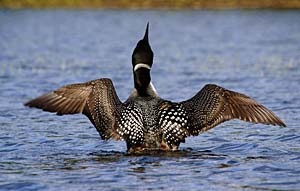
Whatever the reason for being out in the woods, it is the atmosphere, heavy with mystery and adventure that rounds the experience. The miles of unbroken timber, the endless expanses of water and the distant mountains, wild from start to finish. These are all elements of an untamed world where the senses, deadened from modern day overload are awakened to simpler pleasures. Encounters with wild animals highlight any wilderness trip through a secluded landscape. Although many are curious in places where people seldom venture, their curiosity is short lived as they turn back to hidden homes and secret lives amongst the trees.
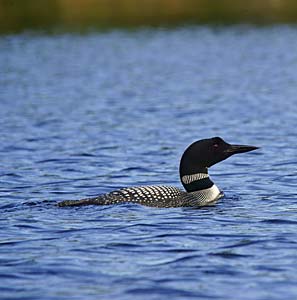 The loon is also cautious, tremoling and using evasive manoeuvres at the first sign of intrusion. It will establish a comfort zone in which a canoe is allowed to pass but will sink low and dive to resurface at a distance when the line is crossed. The birds are a constant accompaniment to fishermen in canoes as they display their expertise in this area. Especially adapted to living on the water, their large webbed feet provide a powerful thrust from legs set well back on their bodies. This off balance arrangement makes movement on land difficult and thus the birds are never more than a short hop from open water.
The loon is also cautious, tremoling and using evasive manoeuvres at the first sign of intrusion. It will establish a comfort zone in which a canoe is allowed to pass but will sink low and dive to resurface at a distance when the line is crossed. The birds are a constant accompaniment to fishermen in canoes as they display their expertise in this area. Especially adapted to living on the water, their large webbed feet provide a powerful thrust from legs set well back on their bodies. This off balance arrangement makes movement on land difficult and thus the birds are never more than a short hop from open water.
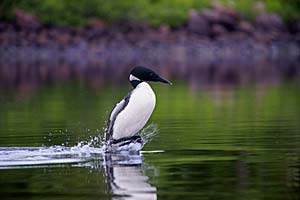 Dipping their heads to peer through the depths, red eyes filter the murky underwater light to locate small trout, leeches and insects that are grabbed between their sharp pointed bills. Solid heavy bones add ballast as they make deep plunges beneath the surface, reaching depths of more than 200 feet. This extra payload needs a long runway to get airborne, as larger ponds and lakes provide the long distances necessary to gain enough speed for a lift off on windless days. Once aloft the birds move like bullets, speeding at 75mph, wings appearing to spin like weather vanes, audibly slicing the air. They are easily identified in flight, with backs arched, head low and feet pressed tight against the body in an elongated cigar shape.
Dipping their heads to peer through the depths, red eyes filter the murky underwater light to locate small trout, leeches and insects that are grabbed between their sharp pointed bills. Solid heavy bones add ballast as they make deep plunges beneath the surface, reaching depths of more than 200 feet. This extra payload needs a long runway to get airborne, as larger ponds and lakes provide the long distances necessary to gain enough speed for a lift off on windless days. Once aloft the birds move like bullets, speeding at 75mph, wings appearing to spin like weather vanes, audibly slicing the air. They are easily identified in flight, with backs arched, head low and feet pressed tight against the body in an elongated cigar shape.
The universal appeal of the loon as an icon of the northern wilderness is due to its incredible vocals that travel far across the open water on windless nights. The laughing heckles of the alarm call is well known as it betrays the presence of even the most cautious hunter. This same call is also a greeting to other loons. The male announces territory with a repetitive yodel that rises in pitch and is a marker for identification. A lonely wail is used to find a mate during the night and a short hoo locates nearby family members. The birds are most vocal in the breeding season and can be heard throughout the night in August when the young of the year seem to be honing their newly acquired skills.
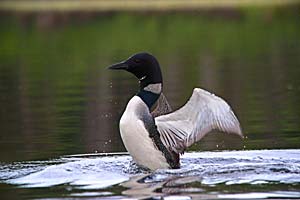 The young chicks dressed in dark brown downy feathers, climb on the backs of their parents to stay dry and safe from predators in their first two weeks. The normally cautious birds will literally turn on their tails to rush an intruder when the chicks are threatened. The "penguin display" is a spirited attempt to distract attention from an escaping chick. The displaying parent dances across the water with its webbed feet churning spray as it tucks its head into its chest in a vigorous and determined effort. The birds gradually increase their distance but rush again if followed.
The young chicks dressed in dark brown downy feathers, climb on the backs of their parents to stay dry and safe from predators in their first two weeks. The normally cautious birds will literally turn on their tails to rush an intruder when the chicks are threatened. The "penguin display" is a spirited attempt to distract attention from an escaping chick. The displaying parent dances across the water with its webbed feet churning spray as it tucks its head into its chest in a vigorous and determined effort. The birds gradually increase their distance but rush again if followed.
The birds migrate to winter on the south coast and can be seen in sheltered coves along the ocean when the freshwater ponds begin to freeze. By this time, the striking black-and-white checkered back, iridescent black head and white neck banding of breeding plumage is replaced with an inconspicuous grey. The young loons stay on the ocean until returning in their third year to the breeding ponds of their birth.
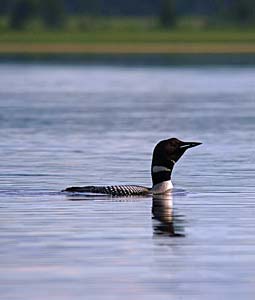 The loon as been in existence for at least 60 million years, fossil records have determined that it is the oldest living bird having evolved to its optimum design long ago. The modern day ravages of pollution and lost habitat are as catastrophic to wildlife as any natural phenomenon. Loons are especially susceptible to oil spills as are all birds who frequent the south coast for any period of their life cycle. The shipment of off shore oil has introduced an additional threat along with the long-standing frequent flushing of bilge tanks from passing ships. The lack of onshore facilities for this function has made oiled birds a fact of life in a territory that contains some of the largest seabird colonies in the world.
The loon as been in existence for at least 60 million years, fossil records have determined that it is the oldest living bird having evolved to its optimum design long ago. The modern day ravages of pollution and lost habitat are as catastrophic to wildlife as any natural phenomenon. Loons are especially susceptible to oil spills as are all birds who frequent the south coast for any period of their life cycle. The shipment of off shore oil has introduced an additional threat along with the long-standing frequent flushing of bilge tanks from passing ships. The lack of onshore facilities for this function has made oiled birds a fact of life in a territory that contains some of the largest seabird colonies in the world.
Pesticides are concentrated in fat reserves that the birds draw on at leaner times of the year. Infertility , thin egg shells and a weakened condition result. Since most of our fresh waters are contained in reservoirs, the birds at the top of the food chain are dependant on fish containing mercury levels that have been concentrated many times. The prevailing winds carry sulphur emissions that condense as acid rain, killing fish and leaching mercury into reservoirs with already high levels from the trees rotting below the surface. Reservoirs have the added disadvantage of fluctuating water levels that can either flood or strand a nest located at the waters edge.
The exposed eggs, abandoned by the sitting adult when intruded on, are vulnerable to the hot sun and weather and are easily spotted by winged scavengers. Loons are seldom found near populated areas and landfills where crows and gulls proliferate. Isolated, wind protected beaches are safe from swells and the sudden wash from passing speedboats that swamp the low lying nest sites and discarded fishing lines that entangle the birds.
Loons are a true symbol of northern wildness. Their familiar calls are often heard throughout our ponds lakes and wetlands. Echoing through time as a constant reminder of our need to value nature and protect it for future generations.
